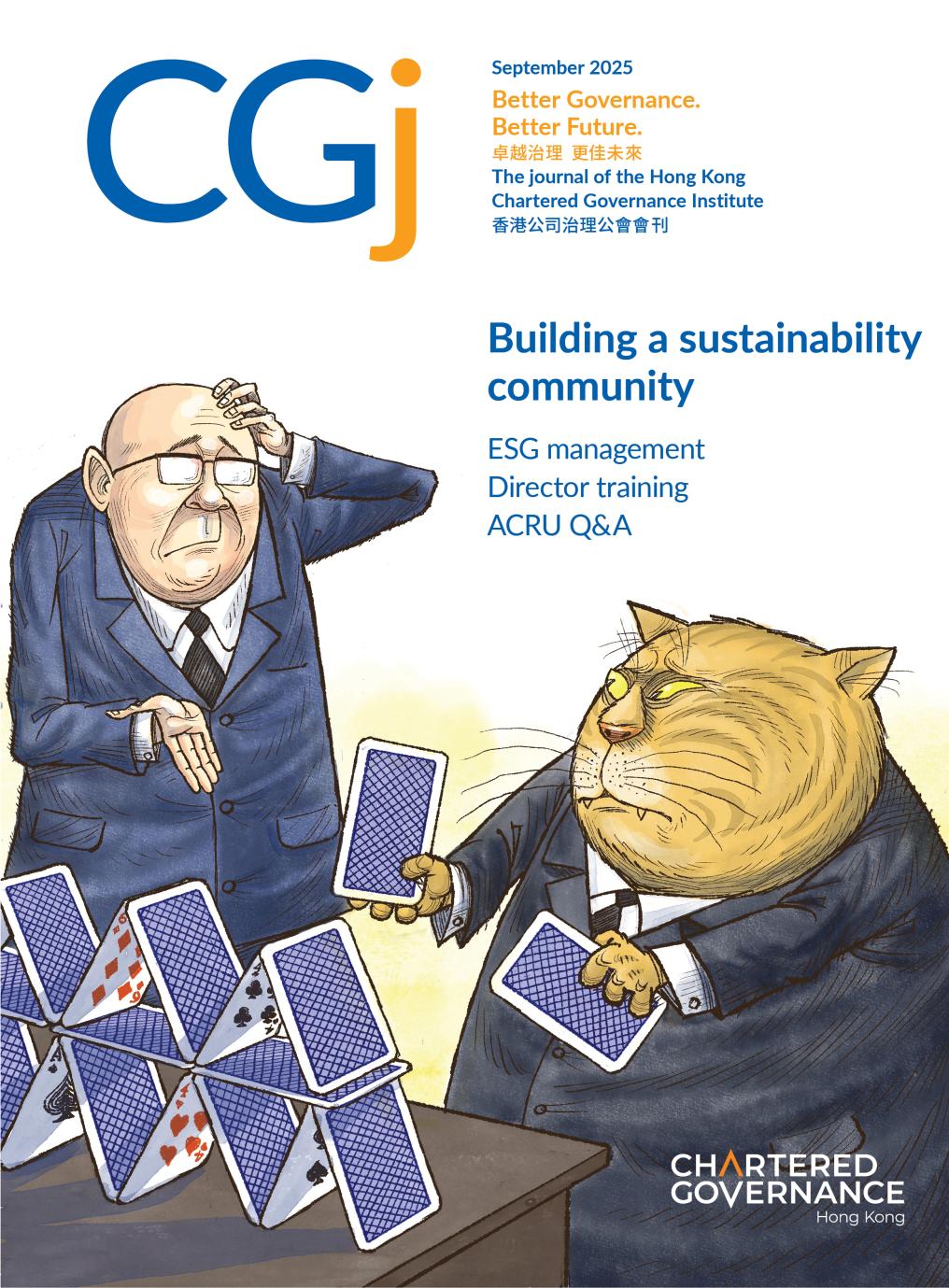
ACRU 2025 – thematic Q&A: part one
Hong Kong’s top regulators respond to questions arising from the Institute’s 26th Annual Corporate and Regulatory Update (ACRU), held in June this year, on topics ranging from regulatory updates and financial reporting to the new USM regime.
This year’s ACRU attracted a record number of participants and generated huge interest in the pertinent governance issues discussed by the key government authorities and regulators speaking at the conference. The Institute followed up with the regulators and has collated a thematic Q&A in response to questions posed by the participants. In part one of this Q&A, Hong Kong Exchanges and Clearing Limited (HKEX) and the Securities and Futures Commission (SFC) contribute their insights.
Feedback on the first set of themes – financial reporting and results publication; director conduct, enforcement and governance; and listing policy and market regulation – was provided by HKEX.
Financial reporting and results publication
What are the most frequent or significant deficiencies identified in the Review of Issuers’ Annual Reports 2024?
‘The issues we observed include misconduct causing listed issuers to act not in the best interests of the issuers and their shareholders as a whole, during both the listing application and after listing. We also observed dereliction of duties by directors, despite express warnings or when being confronted with clear red flags, and noncompliance with Chapters 14 and 14A of the Listing Rules.’
What specific steps or best practices does the Listing Division recommend to address these deficiencies? And how does the Division monitor the implementation and effectiveness of those recommendations?
‘Our Review of Issuers’ Annual Reports 2024, published in December 2024 and now under a new format to facilitate review, summarises the common pitfalls in issuers’ annual report disclosures. To emphasise, the issuers’ compliance rate was very high in terms of disclosing items specified by the Listing Rules, but there is room for improvement in the quality of such disclosure, particularly in the MD&A section. In this regard, we have provided recommendations for issuers to enhance the usefulness of the information presented to investors, instead of merely ticking boxes. We are looking to see improvement over time through market education and our ongoing monitoring of, and interactions with, the relevant issuers.’
What is the most common cause of delay in results publications – internal control weaknesses or poor audit planning? Which of these causes is easier to remedy?
‘It is not uncommon for delinquent companies to exhibit both – or more – issues, and it is therefore not always easy to categorise. A more fundamental issue underlying the delays that we wish to call out is the governance culture, in other words, how important the board considers financial reporting to be. This mentality determines the level of management attention and resources that will be put into it – whether the issuer is willing to invest in building robust reporting and control systems, or whether it decides to proactively manage the audit through, say, identifying key risk areas and procuring adequate documents or evidence to facilitate audit, engaging professional parties early and following through, among others.
The lack of understanding of the importance of financial reporting – and consequently the failure to prioritise it – was manifested in an increased number of issuers that failed to settle audit fees for the previous year, resulting in auditors declining to commence the current year’s audit.
We urge directors to establish a sound corporate governance culture, setting the tone from the top, and to allocate adequate corporate resources to the issuers’ financial reporting function.’
Could you elaborate on the key roles and responsibilities of the audit committee in the context of financial reporting?
‘The audit committee should take proactive steps to ensure that the financial statements give a true and fair view of the issuer’s financial position. For example, the audit committee should closely monitor the audit process and ensure that all audit issues are addressed in a timely manner. Our November 2023 report, A Snapshot of INEDs’ Roles and Responsibilities, provides practical guidance on this matter.’
Are there any examples of insufficient disclosure related to expected credit losses?
‘Some issuers merely give generic or boilerplate descriptions, without providing any explanation in relation to their own facts and circumstances. For example, where there was a significant change in the expected loss rates from the previous year, one issuer simply stated that: “The current loss rates are calculated based on the historical loss rates and adjusted to reflect current and forward-looking information,” without elaborating on the reasons for such a change.’
Director conduct, enforcement and governance
Are NEDs and INEDs assessed in the same light as executive directors in enforcement cases? If so, isn’t that overly onerous, given their different levels of involvement? If not, what level of oversight is considered sufficient to discharge their responsibilities?
‘For our expectations of how NEDs and INEDs should discharge their duties, please refer to pages 3 to 6 of the May 2025 edition of the Corporate Governance Guide for Boards and Directors, published by The Stock Exchange of Hong Kong Limited (the Exchange).’
Under updated Listing Rule 3.09G and section B(i) of Appendix C1 of the Corporate Governance Code (CG Code), must a company with a 31 December 2025 year-end implement the five-topic CPD training in 2025? Is it correct that the requirement and disclosure only apply to the financial year starting 1 January 2026?
‘For issuers with a 31 December 2025 year-end, the disclosure requirements for the new mandatory director training will be implemented starting from the 2026 reporting year only. However, directors will have to comply with the training requirements from the effective date of the new CG Code, for example, starting from 1 July 2025.’
Listing policy and market regulation
What is the Exchange’s stance on noninvestment-business listed companies investing in securities? Should such investments be curtailed or further regulated beyond the current notifiable transaction rules? Will regulators consider granting waivers to directors for dealings during restricted periods, if conditions are predetermined?
‘In our newsletter published on 20 June 2025, we highlighted some commonly observed issues in listed companies’ securities trading activities, and provided guidance with a view to improving governance and transparency in that space. We will continue to promote good corporate governance through market education, combating misconduct identified in individual cases, as well as our ongoing review and refinement of our rules to ensure they continue to be fit for purpose.
The “waivers to directors for dealings during restricted periods” in the question appears to refer to the Model Code for Securities Transactions by Directors of Listed Issuers, which serves to address concerns about directors taking advantage of unpublished material information when dealing in their issuers’ securities. Any request for a dispensation from the Code, or any other rules, will be evaluated against its policy intent and whether the specific circumstances surrounding the transaction in question will give rise to or mitigate the concerns that the relevant rule is designed to address. This is necessarily considered on a case-by-case basis.’
Does the Exchange use AI to check compliance with the Listing Rules? If so, what AI tools are used?
‘We started using bespoke AI software in vetting issuers’ documents a few years ago, initially for annual reports but now extended to interim reports and certain types of announcements and circulars.’
How many new listings are the IPO proposals expected to attract, especially among Chinese mainland companies?
It is not possible to predict the number of new listings that will be attracted by this reform, as it will depend on several factors, including the macroeconomic environment, the stage of development of each listing candidate and the availability of alternative exit opportunities.’
Uncertificated securities market (USM) regime
Questions relating to the USM regime were addressed by both HKEX and the SFC.
Will listed companies be allowed to amend their articles of association at their next AGM after being notified of USM participation, or will they need to hold an EGM?
HKEX: ‘We are not mandating that issuers call an extraordinary general meeting (EGM) to amend their constitutional documents for the USM regime. Issuers should plan their USM participation date, with their share registrar, to be on a date that allows them to use an annual general meeting (AGM) to amend their articles of association beforehand, if they wish to use their AGM for that purpose.’
SFC: ‘Issuers will have around three to six months’ advance notice of their participation date. Depending on when an issuer’s AGM is scheduled and when notice of their participation date is given, it may not always be possible to wait for the AGM to amend their articles of association. In such a case, issuers may instead have to convene an EGM.
Issuers should therefore start the process of reviewing and amending their articles as soon as possible, and should not wait until nearer their expected participation date.
To facilitate this process, the SFC will be issuing guidance for issuers, which will include information on the preparatory steps needed, as well as some sample provisions that issuers may refer to when considering how best to amend their articles, bye-laws and other constitutional documents. We are currently planning to issue these in Q3 this year.’
What is the rationale for allowing five years for participation in the USM regime, given the one-year deadline to amend constitutional documents?
HKEX: ‘A five-year participation deadline is needed so that HKSCC Nominees Ltd and approved securities registrars (ASRs) can ensure that all listed issuers within scope can transition to the USM in an orderly manner. The one-year deadline for issuers to amend their constitutional documents is to ensure that issuers are prepared for that transition well ahead of their participation deadline, which may be anytime within the five-year period.’
SFC: ‘There are currently over 2,500 listed issuers and about 16 million physical certificates in circulation, of which over five million are held in the Central Clearing and Settlement System (CCASS).
The five-year timeline seeks to provide a degree of certainty to the market as to when the transition process will be largely completed. This is important given the cost implications of running parallel systems for securities that have transitioned to the USM regime and for those that have not.
Additionally, given the volume of issuers and certificates involved, and with a view to ensuring an orderly transition to the new regime, a more detailed timetable will be set whereby a specific deadline falling within the overarching five-year timeline will be specified in respect of each issuer, taking into account its size, the number of title instruments in circulation, any upcoming or planned corporate actions, the need for amendments to its terms of issue and so on.’
How prepared are share registrars to support the USM? How many ASRs are expected and what additional costs will listed companies incur?
HKEX: ‘We are actively collaborating with the SFC and the Federation of Share Registrars to ensure that ASRs are operationally prepared for the USM regime. We encourage all issuers to consult directly with their securities registrar to confirm their readiness timelines and their specific capabilities for supporting clients in the USM environment.’
SFC: ‘Share registrars who wish to continue providing share registrar services after the USM regime is implemented must apply to the SFC to become an ASR. This is irrespective of whether they intend to provide USM-related services from the outset or at a later date.
The SFC has provided a detailed timetable to existing share registrars regarding the application process, which includes by when applications must be submitted, by when all substantive questions from the SFC must be satisfactorily addressed and by when all remaining questions must be satisfactorily addressed.
The SFC is currently reviewing the applications received and is therefore not yet able to confirm the readiness of individual share registrars.
On the issue of costs, while these will initially be incurred by HKEX and share registrars, it is only reasonable to expect these to eventually be shared among all stakeholders, including issuers. Issuers should engage with their share registrar as soon as possible to discuss their concerns around costs.’
Will a designated webpage displaying the ASR for each listed company be available to assist registered shareholders?
HKEX: ‘The identity of an issuer’s current securities registrar is already available on the HKEX website. Please visit the Company Profile page for each issuer on the relevant HKEX webpage. This webpage has a field that shows the registrar for that issuer. After USM implementation, this webpage will also show the identity of an issuer’s ASR.’
Will HKEX provide an announcement template for issuers regarding the latest date for converting prescribed securities to participating shares?
HKEX: ‘Our Information Paper on Rule Amendments to Implement an Uncertificated Securities Market and Issuer Platform, issued in May 2025, sets out all the disclosures that issuers must make for USM-related purposes, as well as the content of those disclosures. We plan to elaborate on the form and content of the announcements required under USM in a guidance note to be published on the HKEX website, which we will also update from time to time.’
Will there be any fees charged to USIs for opening accounts to hold paperless securities? If not, where are the accounts opened?
SFC: ‘ASRs may charge investors a fee for setting up a USI Facility. The fee will be subject to the limit set by the SFC, which is HK$50 per USI Facility for individuals. More details are provided in the SFC’s consultation conclusions issued on 13 June 2025.’
Given the removal of paper certificates, why can’t HKSCC beneficiaries be recorded in the register of members, or opt in to be recorded?
SFC: ‘Under the Companies Ordinance, no notice of trusts may be entered in the register of members. Consequently, investors wishing to be recorded in the register of members must do so in their own names.
That being said, and as is the case today, investors holding securities in CCASS have the option to withdraw their securities from CCASS and register them in their own names. We are mindful that the current process for this is cumbersome and time consuming. However, this will change after the USM regime is implemented and the securities in question have transitioned to the new regime. For example, it will then be possible to hold securities electronically and the process for depositing and withdrawing them from CCASS will be much quicker, simpler and more efficient.’
For unincorporated issuers such as unit trusts, how will readiness for USM be assessed or achieved?
SFC: ‘Only prescribed securities will come within the scope of the USM regime. This includes interests in an authorised collective investment scheme (CIS), but only if such interests are withdrawable from CCASS.
For such CISs, readiness will be assessed in the same way as for other prescribed securities:
- the terms of issue (for example, the constitutional and other documents governing the terms on which interests in the CIS may be held and transferred) will need to be amended to ensure they are consistent with the USM regime
- the issuer must appoint an ASR to maintain the register of holders of interests in the CIS, and to provide an uncertificated securities registration and transfer (UNSRT) system for evidencing and transferring legal title to those interests without paper instruments, and
- the appointed ASR must have confirmed to the issuer that everything necessary for legal title to those interests to be evidenced and transferred through its UNSRT system without paper instruments has been completed, and that the date from which such evidencing and transferring through its UNSRT system may begin.’
What protections are available to USIs if securities are lost without their knowledge?
SFC: ‘As is the case today, entries in a register of holders will continue to be prima facie evidence of title only – and hence could be challenged by evidence to the contrary. In this regard, investors will be receiving annual statements of their holdings, as well as written confirmation of all changes to their holdings or particulars. These can be produced to challenge entries in the register that an investor considers inaccurate.
It is also worth noting that, under the USM regime, it will only be possible for securities to be evidenced and transferred through systems operated by an ASR, which will be regulated by the SFC. ASRs and their systems will thus be subject to a range of regulatory obligations and requirements. These include various standards and requirements under the Code of Conduct for Approved Securities Registrars (ASR Code) relating to system security and integrity. The ASR Code will also require ASRs to have backup client and transaction databases, which are to be kept securely in offline media, and these must include a backup record of the register of holders that is no more than one business day old.’
Under the USM regime, can public investors vote at AGMs without contacting their brokers or banks for physical forms?
SFC: ‘Under the USM regime, investors will have the option of holding securities in their own names and in uncertificated form via USI Facilities. If they do so, they will be able to exercise their shareholder rights directly.
For investors who opt to continue holding their securities in CCASS through a broker, the existing arrangements for attending and voting at meetings will continue to apply, that is, they will need to send voting instructions, or indicate interest in attending, through their brokers to the issuer.’
More information on ACRU 2025, with useful links to all speaker websites, can be found here: https://www.hkcgi.org.hk/newsevent/pd-acru.


